Our late colleague and friend Brian Micklethwait was very good at making people think. In particular he was very good at making me think, and even at times making me write. Often he would say something interesting that would make me write something as a response that I would never think to write for any other reason, and this blog, his own blog and its predecessors are full of articles and comments that were responses to things he started me thinking about. He had a tendency to repost my comments as articles when he found them particularly interesting, and many of our conversations took place in the articles and comment sections of various blogs. He loved posting photos of quirky things, fascinating objects, major pieces of architecture and engineering and interesting maps of places around the world that looked like they might be interesting.
Brian was not a great traveller. He was very pro-American, but he never visited the United States. He had done some travel earlier in life – including some behind the Iron Curtain before it fell, which I wish I had been able to do – but in the final two decades of his life when I knew him, he only ever really left London for regular summer trips to visit some friends in France. He clearly enjoyed this immensely, but travel was too much of a hassle for him unless there was warm hospitality as well as good company at the end of it.
He did, however, inspire me to travel. I saw photos of interesting things on his blog, and I researched them and wanted to go there, and I often did. He found this amusing, but he also liked to talk about what I had seen and photographed with me, so this continued the thoughts and conversations. (I still haven’t been on the Darjeeling Himalayan Railway, alas, although I have been on the similar but not quite as spectacular Matheran Hill Railway south of Mumbai).
In any event, in March this year Brian posted a pictographic map of Berlin in 1440 that he knew nothing of the origins of Berlin, but that he found the map interesting, showing a town or small city on two islands in the river Spree with a third island on the left that was at not that point significantly populated. As it happened, I knew relatively little about the origins of Berlin either, but I was instantly curious. I have been to Berlin many times, but I couldn’t have told you where the original town was. (Actually Berlin was technically two towns at the time – Berlin on one island and Cölln on the other). So I researched it, and discovered that although Berlin had some medieval city walls, these had not protected the city well in the Thirty Years War. The relatively unfortified city had subsequently been fortified into a star fort between 1650 and 1683, at which time the two outer streams of the river surrounding the three islands had been turned into a moat and the inner banks replaced with high walls. These walls then subsided into the swamps on which Berlin was built and were torn down starting in 1734, after which the two outer streams of the river were filled in, leaving only one island. The route of the north-easterly wall/stream was eventually used as the route for the Stadtbahn – Berlin’s main east-west railway. The south-easterly route, well, it was filled in and replaced with a layout of streets. Where it was is not obvious on a map or in a photograph.
I also found some modern maps and photographs of Berlin, and sent them to Brian. The inner island, the Spreeinsel, is recognisably the same between the oldest map and the newest photo, and does still have some remnants of being the important centre, including Berlin’s protestant cathedral, but the northern half northern half of it became the site of Berlin’s greatest museums, many of which have been reconstructed in recent times and restored to something even beyond their pre-WWII glory. In the comments, further conversation ensued. More people got involved in the conversation.
Inevitably in all this, I booked a trip to Berlin to wander around and look at the city from this new (or old) perspective. This was originally booked for April 2021. This was optimistic on my part given the circumstances, but I have actually done a lot of optimistic booking of travel over the last 18 months, the vast bulk of which has subsequently been rebooked, postponed and/or cancelled. (Lots of things have been ludicrously cheap to book due to travel companies promising anything in return for being given even small amounts of money, and have then been deferred to the indefinite future. Hopefully these companies will not now go bankrupt when they are forced to catch up with their liabilities). In any event, this trip was postponed to this month.
And, well, on Friday October 15 I got on a plane having received the awful news earlier in the day that Brian had died that morning.
Trying to find old things in Berlin is a struggle. There was a fairly small town there in 1400, but since then it has been drained, expanded, made a provincial capital, rebuilt, fortified, invaded once or twice, expanded again, demolished, rebuilt again, expanded some more, fortified, rebuilt again and turned into an imperial capital, torn down, blown up, bombed to rubble, blown up some more, turned into a communist capital, demolished again, neglected, expanded some more and rebuilt again and made into a national capital, just giving he highlights. In most cities, the geographical and historical bones stick through. In Berlin, much less so. The watercourses to some extent, but that is all.
I attempted to look for remnants of the old city walls. In most cities it would be helpful to type “[City Name] wall remnants” into Google, but “Berlin Wall Remnants” gets something else. To make things even more complicated there was another wall, the Customs Wall, that was built around 1737 for tax collection purposes (boo). Most Berlin place names refereeing to gates (most notably the Brandenburg Gate) refer to this wall. So, I actually found myself looking at the original maps of Berlin in 1440 (and the later map of the star fortress in around 1683), looking carefully for the rights bends and branches and former branches of the river. I started well, finding a piece of (obviously restored) medieval city wall in Littenstrasse>. But that was it for finding further pieces of wall. I followed the approximate line of Littenstrasse through Alexanderplatz, just to the south of the Stadtbahn along the top of what had been Alt-Berlin.
The street plan had been changed by the centuries and the Prussians and the fascists and the communists, and I found nothing more medieval. I crossed the Spree at Bodestrasse, between the Neues Museum (now again containing the bust of Nefertiti, as it did before 1939) and the Berliner Dom, the now restored protestant cathedral that had still been in post-WWII ruins when I first visited Berlin in 1992. I then doubled back to the top of the island before walking past the Humboldt University of Berlin, through Bebelplatz (site of the Nazis infamous book burnings), past the Roman Catholic St. Hedwig’s Cathedral (at present closed for the East German post-war modernist restoration to be removed and replaced with something more tasteful and less full of asbestos) and Oberwallstrasse, Niederwallstrasse, and Wallstrasssse, the latter three streets following the route (with a little straightening) of the wall of the star fortress, at least some of the bends in the shape of that wall being apparent. And back where I started, but on the other side of the river, having circumnavigated the old cities of Berlin and Cölln.
But there was one more thing to see. When we were looking at old and new pictures of Berlin, Brian’s cousin (I think) David Micklethwait commented that the only building that could be seen in the first, last, and intermediate pictures of Berlin was the Berliner Schloss (Berlin Palace), originally the Churfurstl Schloss (Elector’s Palace), home of the heads of House of Hohenzollern during their long journey from Margraves of Brandenburg to being Emperors of Germany before Kaiser Wilhelm II was forced to abdicate in 1918.
Except, I did some further research and it is stranger than that. Rather than being the oldest building in the later photo of Berlin, the Berliner Schloss is actually one of the very youngest – the current building was completed in 2020. The original building was badly but not irreparably damaged in World War 2. The East Germans at times used it as a backdrop for a War movie (including firing live ammunition at it), partly repaired it and used it as office space, denounced it as a symbol of Prussian militarism, and finally demolished it in 1950, partly for ideological reasons but mainly because they were arseholes. The Palace of the Republic – the East German parliament – was then built on the site. After German reunification in 1990, the new German government demolished this building, partly for ideological reasons and partly because it was full of asbestos.
After much discussion, the Palace was rebuilt as the Humboldt Forum, a museum featuring a reconstruction of the Berliner Schloss on the exterior but with an entirely modern interior. (The result was then denounced by the New York Times as an attempt to hide the history of Prussian militarism). Brian found this amusing, as it fitted in with another of his ideas – the triumph of modernism on the insides of buildings but not so much on the outside. His recent thoughts on this subject came in the context of hospitals, alas.
So, I finished my walk around old Berlin with a visit to the Berliner Schloss / Humboldt Forum. And, well, it’s weirder than that.
If you are going to reconstruct old buildings after a war, there are a few things you can do. You can take what is left, and use modern techniques and designs to rebuilt the rest, leaving you with a building that is half and half new and old. (Lots of buildings in Britain and for that matter in West Germany that were quickly rebuilt after WWII are like this). You can reconstruct the new parts in hopefully a sympathetic and complementary style, but also in such a way that the new bits are obviously new rather than old. (Much of the recent restorations of central Gdansk are like this, and I like them a lot). You can attempt to restore the damaged part of the building to the same design as before. The aforementioned Berliner Dom is an example of this. Or you can demolish the ruins and start again, either in the same style or differently. Rebuilding exactly what was there before (as was done in the centre of Warsaw) perhaps works if you do it right away (as the Poles did) but the longer you leave it, the more the result looks like trite and artificial, at least at first. (For an example, look at the Dresden Frauenkirche. It’s a brand new Baroque building with no wear built to modern health and safety standards)
And well, the architects who rebuilt the Berliner Schloss decided to make the fact that it is a reconstruction obvious, by building the front wall (including the main entrance) and two side walls as perfect reconstructions of the original down to every detail, but the back wall in a rather severe modernist style. Similarly, the main courtyard has three interior walls in the Prussian Baroque style of the original building and one in modernist wall. If you look at the building from the front or the sides, it looks like an (admittedly brand new) Prussian Baroque palace. From the back, it looks like a modernist building. From other angles, it looks mostly like an old building, but not quite.
Does it work? I’m not sure. It would have no chance of working anywhere other than in the strange city of Berlin, which is a mix of old and new and original and reconstructed and broken and repaired and has been a showcase of every German regime for the last 500 years – for good or for bad.
A month ago, and a year ago, and ten years ago, and twenty years ago, I would have talked about all this with Brian when I got back. I might have e-mailed him photos when I was still there. There would have been more sharing of photos and conversing and commenting on blogs. He might well have called me an idiot if I said something I disagreed with. I have no idea whether he would have liked or disliked the rebuilt Schloss Berlin, but he would have had something interesting to say about it. He loved talking about what buildings looked like in the context of the surrounds of the cities they were in, and found that too much architectural commentary didn’t focus on this and instead talked about buildings in isolation. I agreed with him on this point, which is one reason why I go places to see stuff.
Anyway, the point is that I miss Brian. Fuck cancer.
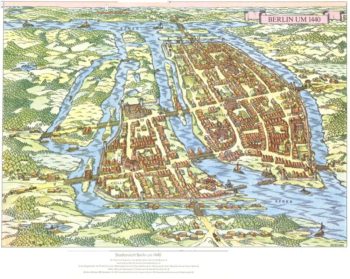
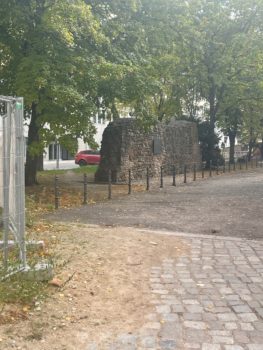
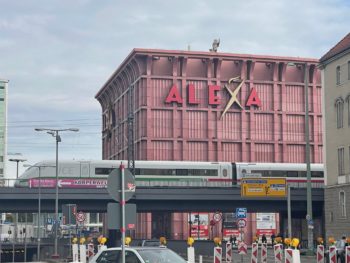
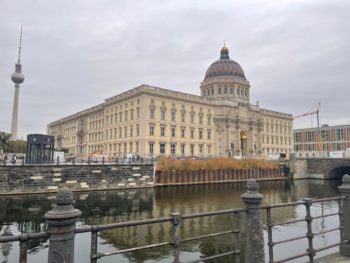
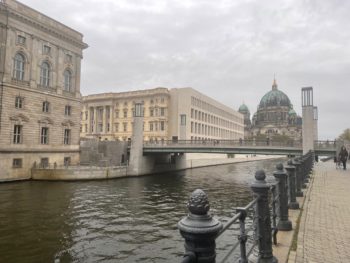




A minor point: German Emperor, not Emperor of Germany. The slight difference represents a real difference and reflects more accurately the Prussian-dominated Second Reich.
I remember when a guest on “Would I Lie To You?” was asked why he had visited Berlin. He replied, “To keep an eye on the Germans.” Nough said!
I was last in Berlin before the wall fell. I believe you. 🙂
As regards
I’ll take an ‘undistressed’ old-looking building (that time will heal by distressing 🙂 ) over an act of concrete brutalism any day.
It also avoids the danger met by the British man who built himself an old-style thatched house, complete with built-in settling, only to have it grade II listed by an inspector who couldn’t understand how his predecessors had missed such an obviously ancient and listable building. The convincingly-faked evidence of age (the builder longed to live in a period house but could not afford a real one) was just a bit too convincing.
I wonder if “three walls traditional, one wall modernist” came out of an uneasy truce after a titanic battle between a PC architectural establishment and some force that gave a damn for the people who would have to pay for it and look at it. (Architecture is one of the areas where the UK PC establishment began meeting real pushback in the 80s. Since then it has had many a vile victory in the UK but has not won the war. I know less of what things are like in Germany.)
Hi Michael
I was the friend in France. I keep remembering a visit of Brian’s some 20 years ago. We criss-crossed Catalunia during major floods, me eager to show him the most interesting sites and both of us being rather scared (but putting on a brave and calm face) of getting stuck in one of the giant puddles while driving in my barely legal Citroen AX . I also remember him only 2-3 years ago, walking across Paris (with luggage!) stopping for a scrumptious lunch (he enjoyed it very much) and him running around to photograph things and people. We would also meet in London and go to the Wigmore Hall where he occasionally fell asleep and snore rather soothingly (it was more like a purr). Hard to accept we won’t be doing this again. I miss him lots.
Hi Mariana,
I had a similar conversation with your elder daughter a few months ago after Brian received his cancer diagnosis. Her: “I just imagined Brian would be here forever – even after the zombie apocalypse.” We the laughed at the thought of Brian running around London taking photographs of the zombies.
My understanding is that the Commies preserved part of the Schloss – the balcony from which a bunch of them declared one of the German Republics of 1918.
I believe that the original balcony was (and is) incorporated into another building nearby, and that the reconstructed Schloss also has a reconstructed balcony. I only discovered this just now, though, so I will have to go and look for the original balcony next time I am in Berlin.
That’s one way to confuse the Commies! Which balcony do they pray to now?
Interesting post.
Berlin would be a nice place to visit (the politics of the city is dreadful – although one could also say that of London, not-that-I-am-saying-that Central Office, please do not hit me) – but I think I would prefer going to the Rhineland again, I think Brian would have liked the Rhineland.
France is a fascinating country – I am glad that Brian visited it as as much as he did.
I have been so occupied getting my New Space company up to doing a capital raise that I had not heard about Brian. What with losing Taylor Dinerman at the start of this year, that is a huge decrease to the intellectual content of planet Earth.
Oh, so Dale is not dead! Long time no write!
Dale Amon has been busy – hopefully he is helping lay the foundations of the private space industry, which will proceed in the centuries ahead.
As Dale Amon well knowns – the key thing will be to break free of government contracts and subsidies, as the government bureaucracy twists and corrupts everything it touches. There is also the economic collapse over the next few years, which is inevitable now, to be considered – but that is just the next few years, Dale Amon is looking to the decades (indeed centuries) ahead.
I am sure that Dale Amon has this well in hand – and that the private space industry will go from strength to strength in the decades and centuries ahead.
We must not be obsessed with the grim few years that are upon the Western World (and, I confess, I have a tendency to be obsesses with this) – we must look to what Winston Churchill called the “bright sunlit uplands” beyond the next few years of horror.